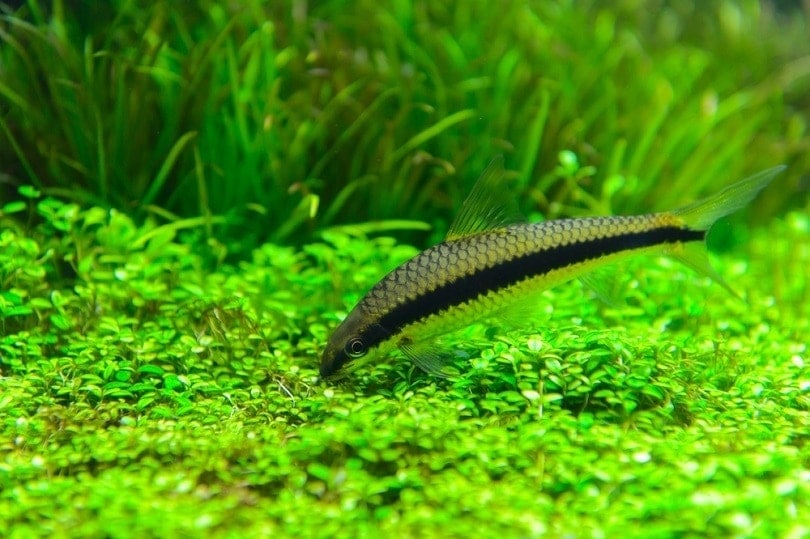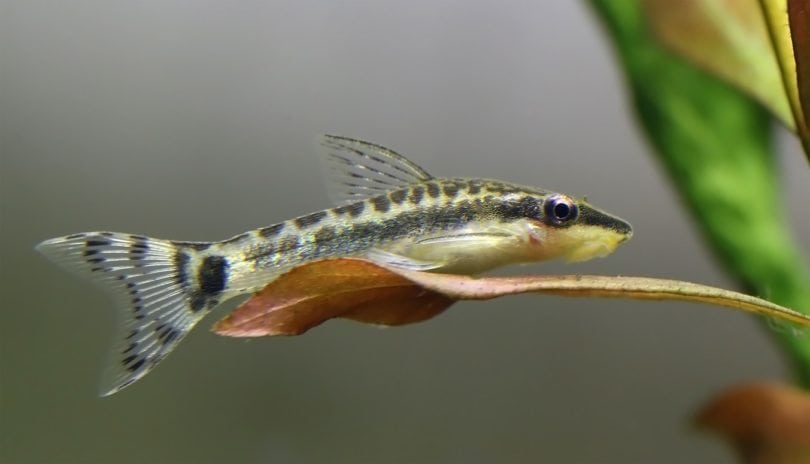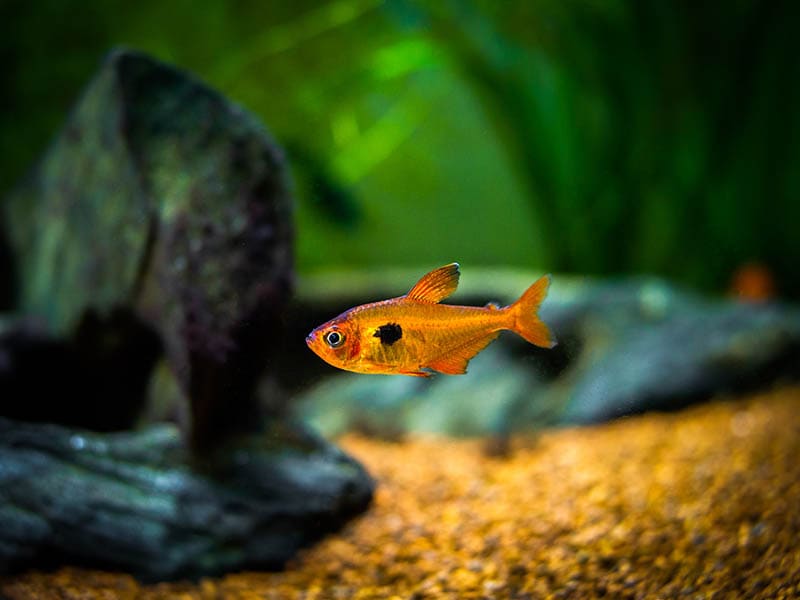9 Best Algae Eater Fish to Help Keep Your Tank Clean (With Pictures)

Updated on

Algae growth can severely diminish water quality and lead to low oxygen levels and poor fish health. Reducing light can help reduce algae levels, while partial water changes should be considered a regular routine in tank care. Another way to minimize algae growth is through the addition of algae-eater fish to your tank population. Algae eaters are especially beneficial if you have live plants in your tank, but different types of algae eaters will eat different types of algae, so it can be a good idea to have a good variety of species.
Below, we have included 9 of the best algae-eater fish to help keep your tank clean.
How Are Algae Eaters Classified?
Algae eaters are fish that consume algae. They tend to reside at the bottom of the tank and hoover up algae as it forms. These helpful little fish need to have their diet of algae supplemented with other food. They will eat the waste from other fish, and they will hoover up leftover food that drifts toward the bottom of the tank. If you have a clean tank that is relatively free of algae, you may need to provide algae discs or suitable pelleted food. Placing items like driftwood will also help encourage different phytoplankton for them to eat.
The 9 Best Algae Eater Fish Breeds
1. Siamese Algae Eater

| Origin: | Southeast Asia |
| Lifespan: | 10 years |
| Size: | 6 inches |
The Siamese Algae Eater is highly prized by freshwater aquarium owners because it consumes red algae, including beard algae. It eats algae from the surface of the water and will consume several types, so it is a good all-rounder. It is also a placid species that will get along well with most other fish in the tank. However, they do need a tank at least 30 gallons in size and owners should supplement their algae, especially if there isn’t enough naturally forming algae in the habitat.
When the Siamese Algae Eater reaches maturity, it will usually stop eating algae altogether, preferring fish flakes and other fish food.
2. Chinese Algae Eater
| Origin: | Southeast Asia |
| Lifespan: | 10 years |
| Size: | 11 inches |
The Chinese Algae Eater is a barbed algae-eating fish that can grow to 10 inches or more in size. Whereas the Siamese Algae Eater naturally eats red algae, the Chinese Algae Eater needs to be trained or persuaded to eat it and prefers black bird algae. However, the Chinese Algae Eater may stop consuming algae if the water temperature drops below 70°F.
It can also be territorial and may become aggressive with other fish in its habitat. Don’t buy Chinese Algae Eaters if you have slow-swimming fish or any with flat bodies.
3. Twig Catfish
| Origin: | South America |
| Lifespan: | 12 years |
| Size: | 4 inches |
The Twig Catfish is a small fish that only grows to around 4 inches in length. It is considered more difficult to keep than most algae eaters but lives off the algae found on plants, wood, and rocks. It is a peaceful fish that can live in pairs and is easy to breed in these conditions, but it can be bullied.
It is a shy little fish that needs a lot of plant matter to hide in and around.
4. Otocinclus Catfish

| Origin: | South America |
| Lifespan: | 2 years |
| Size: | 2 inches |
The Otocinclus Catfish is a tiny algae eater that only grows to around 2 inches in length. It eats the algae from plants, the tank, and other items in the tank, and prefers softer algae growth. It looks similar to the Chinese Algae Eater except it is much smaller and is less inclined to attack other fish in your colony. They are best kept in schools, which means you will need a tank of at least 30 gallons to be able to house Otocinclus, despite their tiny stature.
They are peaceful and won’t attack other fish but can be a target for larger, more aggressive tank dwellers.
5. Whiptail Catfish

| Origin: | South America |
| Lifespan: | 8 years |
| Size: | 4 inches |
The Whiptail Catfish is an algae eater, but it isn’t considered a prolific one because it has an omnivorous diet and will mop up fish food in the tank. It grows to a size of around 4 inches, is considered a placid tank inhabitant, and is considered a good addition to most tanks.
But if you are looking specifically for algae eaters, Whiptail Catfish may not be your best option.
6. Bristlenose Plecostomus

| Origin: | South America |
| Lifespan: | 15 years |
| Size: | 5 inches |
The Bristlenose Plecostomus, most often referred to simply as the Bristlenose Pleco, has a striking appearance with a black body and white spots. It is a peaceful fish that can live with other species. The Bristlenose is a hungry fish so you will likely need to supplement its natural algae diet with some floating algae discs or spirulina flakes.
Ensure the Pleco has plenty of hiding places at the bottom of the tank, where it prefers to hide out, by adding pieces of wood or cave decorations.
7. Mollies

| Origin: | South and Central America |
| Lifespan: | 5 years |
| Size: | 5 inches |
Strictly speaking, Mollies are not really algae eaters, but they will occasionally eat algae if it is available. As such, if you have a small amount of algae growth and want some peaceful fish that live well in community tanks, Mollies can make a good choice. Mollies are livebearers, which means they give birth to live fish.
Like most livebearers, they can reproduce quickly, which means you could have a tank full in no time.
8. Hillstream Loach

| Origin: | Vietnam |
| Lifespan: | 10 years |
| Size: | 5 inches |
The Hillstream Loach looks like a small stingray or a catfish, but is, as the name suggests, a species of loach. It grows to around 2.5 inches and typically has a brown or black body with white or cream blotches. This species does a great job of clearing algae from the glass of the tank, and they look impressive.
They can be aggressive with one another but tend to be passive with other fish, and keeping four or five together can actually help with aggression.
9. Rosy Barb

| Origin: | South Asia |
| Lifespan: | 5 years |
| Size: | 3 inches |
Rosy barbs are omnivores, which means they will eat fish food and flakes as well as fuzzy algae. This means that one or two Rosy Barbs may not be enough to control the algae in your tank, but it is better to keep these in schools of 5 or 6 with more females than males, to help combat aggression between one another.
Keeping this many together should also minimize the risk of them bothering other fish.
Conclusion
As well as the algae-eating fish above, you can also get snails and some shrimp that will help control the algae levels in your tank. When choosing any new tankmate, always consider whether they will get along with existing inhabitants and ensure that you have appropriate tank conditions for all of your tank dwellers.
See Also:
Featured Image Credit: Joan Carles Juarez, Shutterstock












